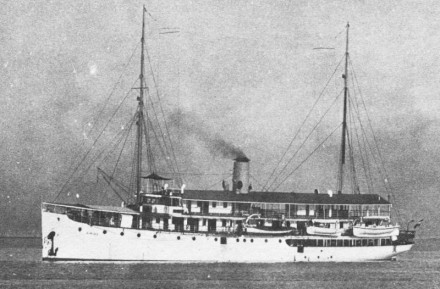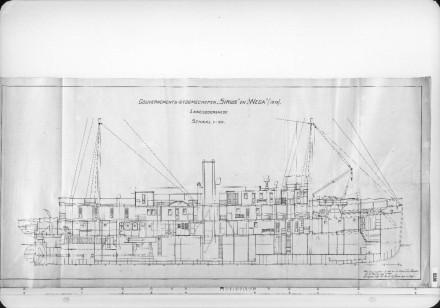History
The Hr.MS. Sirius was a steam ship, commissioned by the Gouvernements Marine (the Navy of the former Dutch East Indies) in 1923. The ship was originally stationed in Tandjong Priok. In the 1930's, the Sirius was stationed in Makassar. In this period, the Indonesian engineer Pieter Octavianus Putuhena worked on the ship.
Natural science expedition
In 1928-1929, Leopold II, then the crown prince of Belgium, traveled along with a scientific expedition through the Dutch East Indies on the Sirius. He collected many natural artefacts, amongst other things butterflies, that he donated to the Museum van Van Straelen (the present-day Museum for Natural Sciences in Brussels). Experts studied the large collection and devoted a special series of treatises to it (Van Straelen 1933).

WWII
From the militarisation in 1939 onward, the Sirius, commanded by C. Hokke, was replaced by the Hr. Ms. Gemma. After this, the Sirius was added to the Hr. Ms. Bellatrix to guard the Sunda Strait. The two ships patrolled in turn so the were stationed in Tjandong Priok half of the time. On February 26th, 1940, the Sirius got a 7.7 mm machine gun for air defense. On February 19th, 1942, the West-Java Guard Service saw the light and the Sirius formed a part of this.
Demise
On February 28th, the Sirius was lying in the Bay of Banten together with the Hr. Ms. Reiger, where the ships were attacked four times by Japanese bombers. The Sirius was struck with much shrapnel on her port side by a near miss. In the beginning of the night, the Sirius fired up the kettles and commander Hokke readied to leave enter the port of Tandjong Priok when the ships were caught in a search light and were subjected to gunfire of Japanese ships. Because his ship was also surrounded by flares that had been dropped by airplanes and thus was an easy prey, Hokke decided to ground the Sirius and open the seacocks. The crew could reach the shore wading through the mud and escape to Batavia (present day Jakarta), where they arrived the next day.
Description
Yard: IJsselyart, Gorinchem (the Netherlands)
Crew: 8 Dutch and 47 Indonesian crewmembers
Propulsion: 1x triple expansion steam engine
Armament:
1x 7,7 mm machine gun for air defense.

| Master | Hokke, C. |
|---|---|
| People on board | 55 |
| Power | 916 hp |
| Speed | 12 knots ~ 14 mph (22 km/h) |
| Length | 182 ¾ feet (55.7 m) |
| Width | 31 ¼ feet (9.5 m) |
| Draft | 10 ¾ feet (3.3 m) |
| Displacement | 1018 ton |
Status
It is unclear what happened to the wreck, but since it was lying in shallow waters, it is possible that it has been salvaged or cleared.
References
- Gouvernements Marine overzicht 1939.
Regerings-almanak voor Nederlandsch-Indië, 1939. - tracesofwar.nl.
Hr. Ms. Sirius. - pp 1.
Nationaal Archief.
4.MST Inventaris van de bouwtekeningen van schepen van de Nederlandse Marine, 1683-1996.
4.MST/5230. - Straelen, V. van (1930).
Résultats Scientifiques du Voyage aux Indes Orientales Néerlandaises de LL.AA.RR. le Prince et la Princess Léopold de Belgique. Vol.I-IV.